What is “Cloudfront.net redirect virus”? Cyber threat analysts has determined that Cloudfront.net redirect virus is a malware that uses a legitimate content delivery network owned by Amazon to redirect users to endless commercials from various merchants.

While your computer is affected with the Cloudfront.net redirect virus, the Chrome, Mozilla Firefox, MS Edge and IE may be rerouted to the unwanted Cloudfront.net web page. Of course, the virus may not cause damages to your files or Windows system, but it may display lots of annoying ads. These advertisements will be injected within the content of pages that are you opening in your browser and can be varied: pop-up ads, in-text ads, different sized banners, offers to install an questionable software. The ads will appear on all web-pages, including sites where previously you have never seen any advertising links.
When the Cloudfront.net redirect virus gets inside your machine, it might carry out various harmful tasks. It can analyze the location and which Internet web-sites you visit, and then present ads to the types of content, goods or services featured there. Ad supported software authors can gather and sell your browsing information and behavior to third parties.
If your internet browser has been infected by the Cloudfront.net redirect virus, you must have finished any of the steps above. Once you’ve removed Cloudfront.net redirect virus from your computer by following our guidance below, make sure not to commit the same mistakes again in the future.
How to remove Cloudfront.net redirect virus
Not all malware such as the Cloudfront.net redirect virus is easily uninstallable. You might see pop-ups, deals, text links, in-text advertisements, banners and other type of advertisements in the MS Edge, Google Chrome, Firefox and Internet Explorer and might not be able to figure out the program responsible for this activity. The reason for this is that many unwanted programs neither appear in Windows Control Panel. Therefore in order to completely remove Cloudfront.net redirect virus, you need to follow the steps below. Certain of the steps below will require you to exit this web-page. So, please read the step-by-step guidance carefully, after that bookmark or print it for later reference.
To remove Cloudfront.net redirect virus, use the steps below:
- Remove potentially unwanted apps through the Windows Control Panel
- Remove Cloudfront.net redirect virus from Google Chrome
- Remove Cloudfront.net redirect from Mozilla Firefox by resetting web-browser settings
- Delete Cloudfront.net redirect virus from IE
- Remove Cloudfront.net redirect virus with free tools
- Run AdBlocker to stop Cloudfront.net redirect
Remove Cloudfront.net redirect virus manually
Read this “How to remove” section to know how to manually remove Cloudfront.net redirect virus. Even if the step-by-step tutorial does not work for you, there are several free malicious software removers below that can easily handle such the Cloudfront.net redirect virus.
Remove potentially unwanted apps through the Windows Control Panel
We suggest that you begin the PC system cleaning process by checking the list of installed applications and delete all unknown or suspicious apps. This is a very important step, as mentioned above, very often the harmful software such as virus and hijacker infections may be bundled with free programs. Remove the unwanted software can get rid of the undesired advertisements or browser redirect.
Windows 8, 8.1, 10
First, click the Windows button
Windows XP, Vista, 7
First, click “Start” and select “Control Panel”.
It will display the Windows Control Panel as on the image below.

Next, click “Uninstall a program” ![]()
It will show a list of all apps installed on your system. Scroll through the all list, and delete any questionable and unknown applications. To quickly find the latest installed apps, we recommend sort apps by date in the Control panel.
Remove Cloudfront.net redirect virus from Google Chrome
If you have virus problem or the Google Chrome is running slow, then reset Chrome settings can help you. In the steps below we’ll show you a solution to reset your Google Chrome settings to original state without reinstall. This will also allow to remove Cloudfront.net redirect virus from your internet browser.
First run the Chrome. Next, press the button in the form of three horizontal dots (![]() ).
).
It will display the Google Chrome menu. Choose More Tools, then click Extensions. Carefully browse through the list of installed extensions. If the list has the extension signed with “Installed by enterprise policy” or “Installed by your administrator”, then complete the following steps: Remove Google Chrome extensions installed by enterprise policy.
Open the Google Chrome menu once again. Further, press the option named “Settings”.

The web browser will display the settings screen. Another solution to display the Google Chrome’s settings – type chrome://settings in the web browser adress bar and press Enter
Scroll down to the bottom of the page and click the “Advanced” link. Now scroll down until the “Reset” section is visible, as displayed in the following example and press the “Reset settings to their original defaults” button.

The Google Chrome will open the confirmation dialog box as displayed on the image below.

You need to confirm your action, click the “Reset” button. The web-browser will run the process of cleaning. Once it is finished, the web browser’s settings including new tab page, default search provider and home page back to the values that have been when the Chrome was first installed on your system.
Remove Cloudfront.net redirect from Mozilla Firefox by resetting web-browser settings
If the Mozilla Firefox settings like start page, search provider by default and newtab have been modified by the virus, then resetting it to the default state can help. Essential information such as bookmarks, browsing history, passwords, cookies, auto-fill data and personal dictionaries will not be removed.
Press the Menu button (looks like three horizontal lines), and press the blue Help icon located at the bottom of the drop down menu as displayed on the screen below.

A small menu will appear, click the “Troubleshooting Information”. On this page, press “Refresh Firefox” button as displayed below.

Follow the onscreen procedure to return your Firefox web browser settings to their original state.
Delete Cloudfront.net redirect virus from IE
If you find that IE internet browser settings had been modified by the Cloudfront.net redirect virus, then you may revert back your settings, via the reset web browser procedure.
First, open the Internet Explorer. Next, press the button in the form of gear (![]() ). It will open the Tools drop-down menu, click the “Internet Options” as shown on the image below.
). It will open the Tools drop-down menu, click the “Internet Options” as shown on the image below.

In the “Internet Options” window click on the Advanced tab, then click the Reset button. The IE will display the “Reset Internet Explorer settings” window as displayed below. Select the “Delete personal settings” check box, then press “Reset” button.

You will now need to restart your PC system for the changes to take effect.
Remove Cloudfront.net redirect virus with free tools
The virus can hide its components which are difficult for you to find out and remove completely. This can lead to the fact that after some time, the Cloudfront.net redirect virus once again infect your machine. Moreover, We want to note that it’s not always safe to remove virus manually, if you do not have much experience in setting up and configuring the Windows operating system. The best solution to scan for and delete virus is to use free malware removal apps.
Run Zemana to remove Cloudfront.net redirect
Download Zemana Anti-Malware (ZAM) to delete Cloudfront.net redirect virus automatically from all of your browsers. This is a free program specially developed for malicious software removal. This tool can remove adware, hijacker from Chrome, Edge, Mozilla Firefox and IE and MS Windows registry automatically.
Please go to the link below to download the latest version of Zemana Anti-Malware (ZAM) for Windows. Save it to your Desktop.
164755 downloads
Author: Zemana Ltd
Category: Security tools
Update: July 16, 2019
After the download is finished, close all windows on your computer. Further, run the install file called Zemana.AntiMalware.Setup. If the “User Account Control” dialog box pops up as on the image below, click the “Yes” button.

It will open the “Setup wizard” that will assist you install Zemana Free on the computer. Follow the prompts and do not make any changes to default settings.

Once setup is done successfully, Zemana will automatically start and you can see its main window as displayed below.

Next, press the “Scan” button for scanning your computer for the Cloudfront.net redirect virus. This procedure may take some time, so please be patient.

When the scan is complete, Zemana AntiMalware (ZAM) will open a list of all items found by the scan. Next, you need to press “Next” button.

The Zemana will remove Cloudfront.net redirect virus and other malware. After the clean up is finished, you can be prompted to reboot your personal computer.
Scan and free your machine of virus with Hitman Pro
Hitman Pro is a free removal utility that can be downloaded and run to remove Cloudfront.net redirect virus and other security threats from your personal computer and web-browser. You can run this utility to detect threats even if you have an antivirus or any other security program.
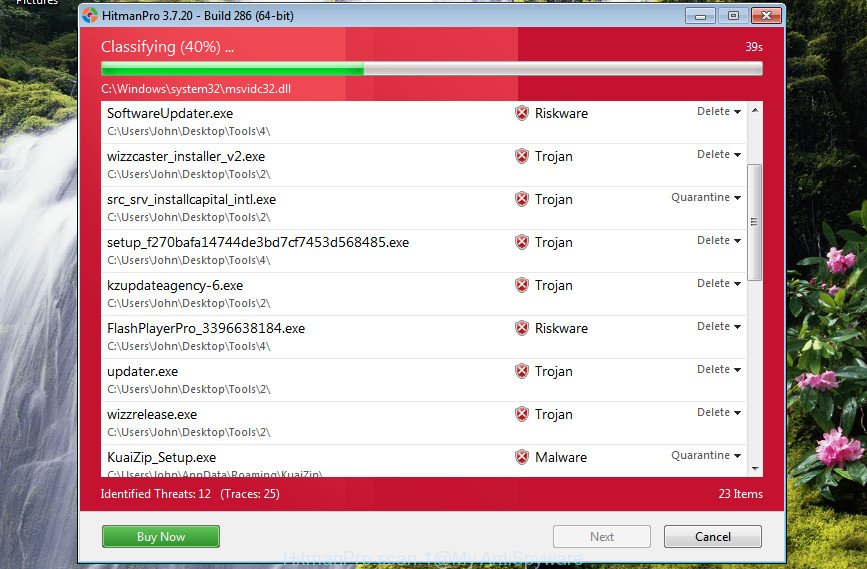
- Installing the HitmanPro is simple. First you’ll need to download HitmanPro on your Microsoft Windows Desktop by clicking on the following link.
- After downloading is complete, double click the HitmanPro icon. Once this utility is started, click “Next” button to perform a system scan with this tool for the Cloudfront.net redirect virus and other security threats. This process can take quite a while, so please be patient. During the scan HitmanPro will scan for threats present on your computer.
- Once finished, Hitman Pro will open a list of all items found by the scan. Once you have selected what you want to get rid of from your computer press “Next” button. Now click the “Activate free license” button to begin the free 30 days trial to get rid of all malware found.
Run MalwareBytes to remove Cloudfront.net redirect virus
Trying to remove Cloudfront.net redirect virus can become a battle of wills between the virus infection and you. MalwareBytes Free can be a powerful ally, removing most of today’s adware, malicious software and potentially unwanted programs with ease. Here’s how to use MalwareBytes will help you win.
Download MalwareBytes Anti-Malware (MBAM) by clicking on the following link.
327024 downloads
Author: Malwarebytes
Category: Security tools
Update: April 15, 2020
Once the download is finished, close all programs and windows on your computer. Double-click the set up file called mb3-setup. If the “User Account Control” prompt pops up as shown in the following example, click the “Yes” button.
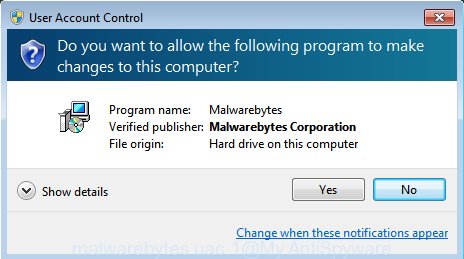
It will open the “Setup wizard” which will help you setup MalwareBytes on your PC. Follow the prompts and don’t make any changes to default settings.
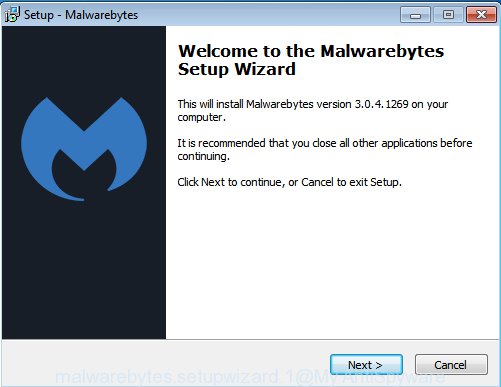
Once setup is done successfully, press Finish button. MalwareBytes Free will automatically start and you can see its main screen as shown on the image below.
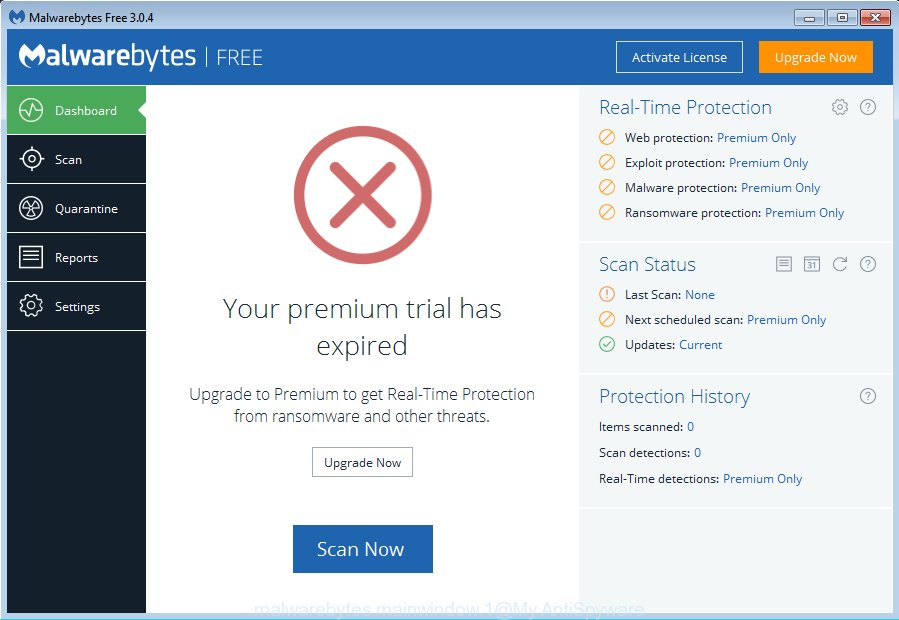
Now click the “Scan Now” button to perform a system scan for the Cloudfront.net redirect virus and other malicious software. This procedure can take some time, so please be patient. While the tool is checking, you may see number of objects and files has already scanned.
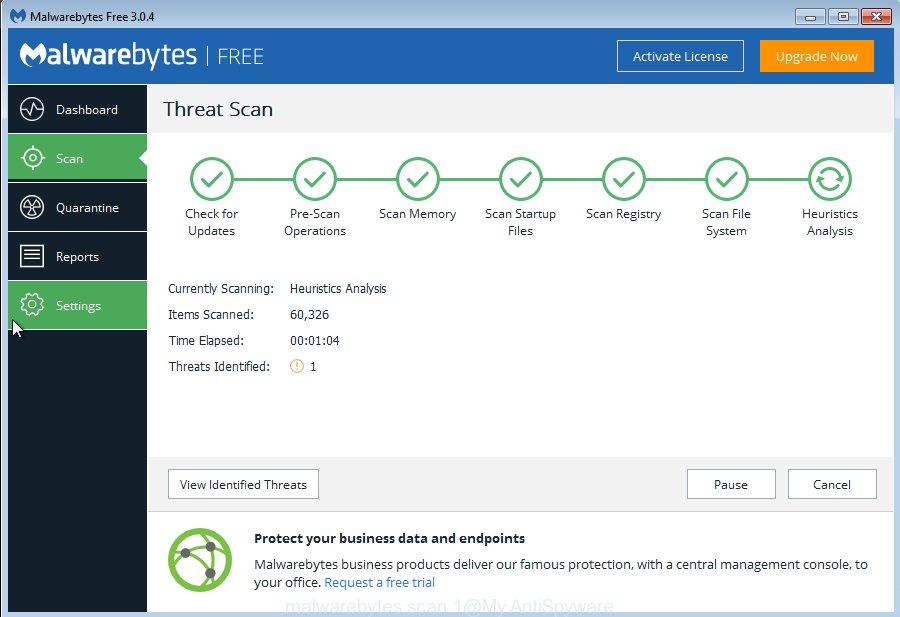
After finished, MalwareBytes will display a list of detected threats. You may delete items (move to Quarantine) by simply click “Quarantine Selected” button. The MalwareBytes Anti Malware (MBAM) will remove Cloudfront.net redirect virus and add items to the Quarantine. After that process is done, you may be prompted to reboot the PC system.
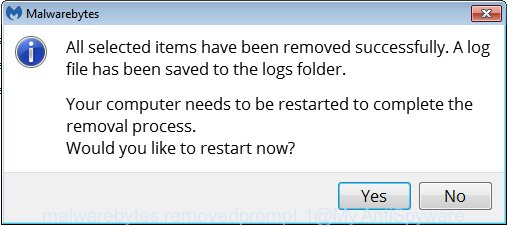
We recommend you look at the following video, which completely explains the procedure of using the MalwareBytes Free to get rid of adware, browser hijacker infection and other malware.
Run AdBlocker to stop Cloudfront.net redirect
Use ad-blocking program such as AdGuard in order to stop advertisements, malvertisements, pop-ups and online trackers, avoid having to install harmful and adware browser plug-ins and add-ons that affect your computer performance and impact your computer security. Surf the Internet anonymously and stay safe online!
- Visit the following page to download AdGuard. Save it on your Desktop.
Adguard download
26831 downloads
Version: 6.4
Author: © Adguard
Category: Security tools
Update: November 15, 2018
- After downloading it, start the downloaded file. You will see the “Setup Wizard” program window. Follow the prompts.
- Once the install is finished, click “Skip” to close the install program and use the default settings, or press “Get Started” to see an quick tutorial which will help you get to know AdGuard better.
- In most cases, the default settings are enough and you do not need to change anything. Each time, when you start your PC, AdGuard will start automatically and block unwanted popup advertisements, stop Cloudfront.net redirect, as well as other harmful or misleading web pages. For an overview of all the features of the application, or to change its settings you can simply double-click on the icon named AdGuard, that can be found on your desktop.
How can you prevent the Cloudfront.net redirect virus
The Cloudfront.net redirect virus come along with certain free programs. So always read carefully the setup screens, disclaimers, ‘Terms of Use’ and ‘Software license’ appearing during the install process. Additionally pay attention for additional applications that are being installed along with the main program. Ensure that you unchecked all of them! Also, run an ad-blocker program that will help to stop malicious, misleading, illegitimate or untrustworthy web-pages.
Finish words
Now your computer should be free of the Cloudfront.net redirect virus. We suggest that you keep Zemana Anti Malware (to periodically scan your machine for new viruss and other malware) and AdGuard (to help you block unwanted advertisements and malicious web-pages). Moreover, to prevent any virus, please stay clear of unknown and third party apps, make sure that your antivirus program, turn on the option to find out PUPs.
If you need more help with Cloudfront.net redirect virus related issues, go to here.



















